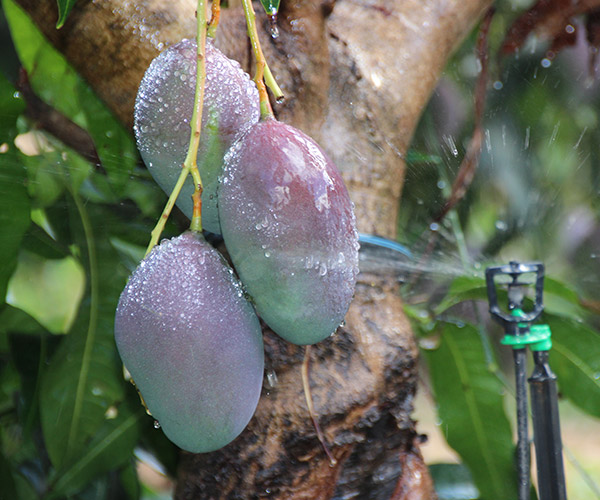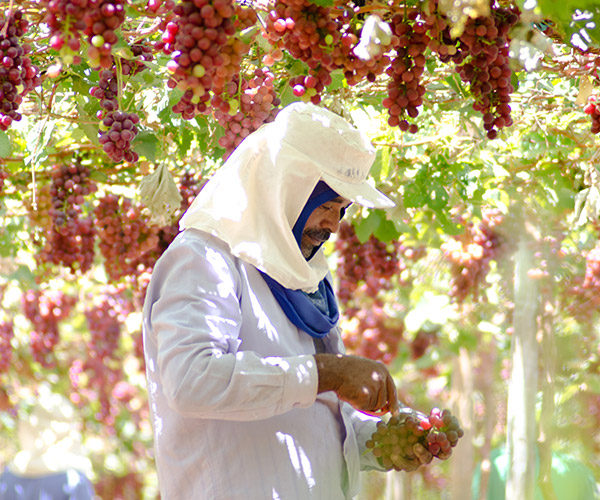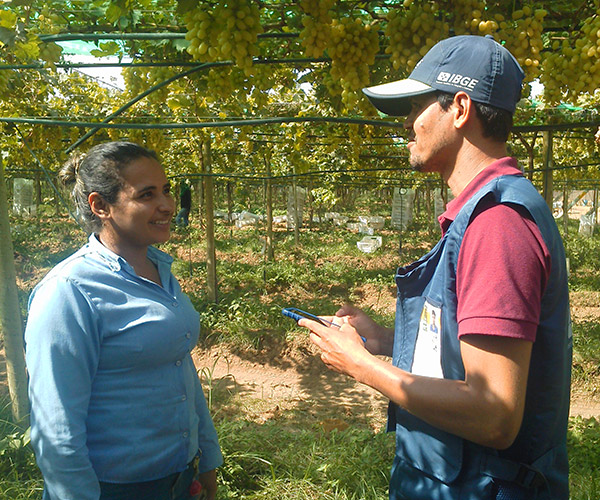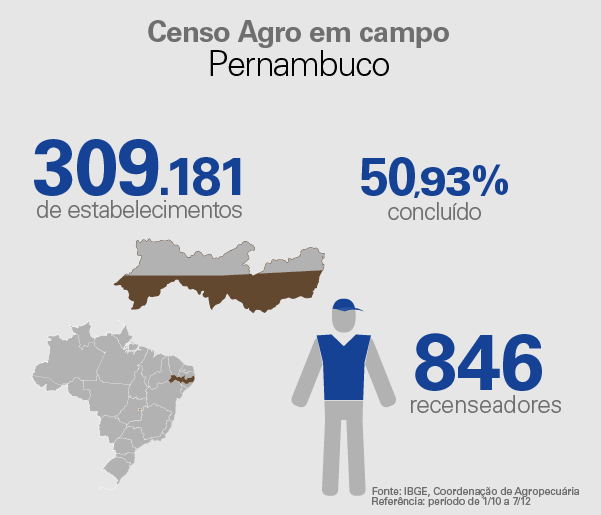In São Francisco Valley, Census of Agriculture harvests data from fruits that win the world
December 11, 2017 09h00 AM | Last Updated: June 05, 2018 03h49 PM
Forget that only cactuses exist in the Sertão, and that people and animals suffer from water shortage. The picture is completely different in the São Francisco Valley, a region around this river in the states of Pernambuco, Bahia and Minas Gerais, a hub of irrigated fruitculture in Brazil. In the field from October this year up to February 2018, the Census of Agriculture is tasked with collecting data on the vegetal and animal production in this area.
In the city of Petrolina, in the Sertão of Pernambuco, 16 enumerators are tasked with collecting information on nearly 5,300 agricultural establishments. To assure that every area is covered by the census, the IBGE hired four boatmen to take the enumerators to the islands and guide them, as explained by Francisco José de Carvalho, person in charge of the subarea of Petrolina.
"Eight islands in the Old Chico in Petrolina produce agricultural products. They are 11 in the municipality of Santa Maria da Boa Vista, highlighted by the production of bananas. Six boats help the census there", tells Francisco. The enumerators use to carry private motorcycles in the boats, to help them to travel in the land. "We had a curious case: the enumerator in charge of the Massangano Island in Petrolina fell in love with that region. He spent 14 days there, enumerated 130 establishments and told that he intends to get back to live there once and for all", tells Francisco José about the island that is a highlight in the production of mangoes.

São Francisco River crosses agricultural properties in Pernambuco
River water gives life to plantations
Made by Hungarian and Israeli studies, the first public projects of irrigation in that region took place in the 1960s. The most developed irrigation hub in the valley is located around the cities of Juazeiro (BA) and Petrolina (PE). According to information from the Development Company of the São Francisco Valley - Codevasf, seven Public Projects of Irrigation - PPIs are installed in that region, two of them in Pernambuco: Senator Nilo Coelho and Bebedouro; and five in Bahia: Curaçá, Maniçoba, Tourão, Mandacaru and Salitre.
According to economic data from Codevasf, the most significant results of the Gross Value of Production in 2016 came from the PPIs of Senator Nilo Coelho (R$1.39 billion), Curaçá (R$135 million), Maniçoba (R$116 million), Tourão (R$101 million), Bebedouro (R$44 million) and Mandacaru (R$9 million). Today, these irrigation projects are expected to generate about 81 thousand indirect jobs and 54 thousand direct ones, adding up to 135 thousand jobs in 2016.
According to the Codevasf Management Report, the area cultivated in the projects in 2016 was of 54,015 hectares, mainly producing grapes, mangoes, guava and sugarcane, either through temporary or permanent crops.
Efficient use of water and land
The history of the development in that region is tightly coupled with that of the São Francisco River, from where water is taken to the plantations. "The irrigation using water river began in a comfortable and beautiful way, spending much water through the use of the less-efficient techniques of conventional sprinkling and center-pivot irrigation, as a significant part of the water sprinkled is lost due to the wind", explains Rosimar Musser, teacher at the Agronomy Department of the UFRPE.
Today, other technologies are in use, like the techniques of micro-sprinkling and dripping. "Water comes straight from the tree foot, which rationalizes its use", completes the researcher. In the same direction, Codevasf has also been emphasizing the efficient use of water and soil. "Codevasf and the Ministry of National Integration developed and provided the producers with projects to modernize the irrigation. With these projects in hands, the farmers can look for funding to convert the conventional irrigation to the micro-sprinkling system, which could save up to 60% in some cases", explains Andrea Rachel Sousa, manager of Codevasf´s Production Support.

Mango irrigated crop in São Francisco Valley
These changes in terms of the way of production are being noticed by the 10th Census of Agriculture. Maria Deuzimar Gonçalo, 27 years, is an enumerator in Petrolina. Before working at the IBGE, she worked in the countryside, which gives her a lot of experience when applying the Census questionnaire. "My labor sector is close to home, what makes things easier. I used to work in a number of those sectors, so I already wondered what I would find, I already knew the reality in each one of them", details Deuzimar.
"The reality 10 years ago is quite different than that of today. Most lots have been split. I managed to find lots with more than ten persons in charge: the father divided them among his children and each one had his/her part" explains the enumerator. To apply the questionnaires, she uses a motorcycle, a bicycle and sometimes she goes on foot.
Taiane Gomes, 26 years, is enumerating establishments in the Nilo Coelho project. Weather is the major difficulty for her. "I usually work from 6am to 12pm. It is hard to find the owners in the lots in the afternoon. Many times the questionnaire is applied while the persons are working in the plantation, so it is a strong sunlight", states the enumerator. The weather directly influences the life of those living in the countryside. The temperature were slightly lower in Petrolina this year, impacting the planting of grapes. "As it was colder, the producers have been complaining to use more pesticides to control pests, which lead to an increase in the production costs", details Taiane.
Grapes and mangoes from Sertão to abroad
"The Petrolina-Juazeiro axis concentrates the biggest fruitculture hub in Brazil, highlighted by the production of grapes, mangoes, guava and sugarcane", states Ricardo Chaves, teacher at the Federal University of Pernambuco and holding a PhD in agricultural economy. According to the information from Vale Export, that region produces about 604 thousand tonnes of mangoes and 252 thousand tonnes of grapes. The fruits are sold in the domestic market and also exported. According to the AliceWeb data, the major importers of these fruits in 2017 are the Netherlands, United Kingdom, the United States, Spain, Germany, Canada and Argentina.
Many people might get surprised to know that that area in the Northeastern Sertão stands out in terms of planting grapes, a fruit typical from a milder climate. Table grapes – consumed in natura – and wine grapes – used to produce wine and sparkling wine – are produced, as well as the agribusiness uses low-quality fruits to produce juices, preserves and dried fruits. The São Francisco Valley is a very particular place for cutting-edge fruitculture, explains the agronomist Rosimar Musser: "Staggering the production is the major differential. Through the use of appropriate techniques, it is possible to let a plant rest whenever you want and also harvest it whenever you want. As a result, we manage to have two harvests per year rather than only one as in most localities", details the researcher.

Grape harvest in São Francisco Valley
Eleven hectares of table grapes have been planted in the Liberdade Agropecuária Farm. Most of the production is exported, being the United States the major destination. "The 26 workers produce, on average, 300 tonnes per year. All this is only possible thanks to irrigation", states the administrative assistant of this property. Juvenal de Brito, 45 years, takes care of Mãe Terra Ranch. The property has 10 hectares, where 250 to 300 tonnes of mangoes are produced per year. "Employment is not a problem for the courageous ones", states the administrator from Afrânio, in the Sertão of Pernambuco, who lives for 18 years in Petrolina. Up-to-date data show the economic and social development of this municipality. "According to the IBGE, the Petrolina GDP changed from R$725.4 million in 2010 to R$5.2 billion in 2014 and the Municipal Human Development Index - HDI-M from 0.580 in 2000 to 0.697 in 2010", highlights Andrea Sousa, manager at Codevasf.
Opening the gates for Census of Agriculture
The main task of the Census of Agriculture is to collect up-to-date information on the agricultural sector. In Pernambuco, it is expected to collect data relative to about 309 thousand agricultural establishments. Nearly 850 enumerators are visiting every city in the state, which is divided into 18 subareas and 49 data collection stations. In the last census, carried out in 2006, Pernambuco was the sixth state in Brazil with the highest number of units, after Bahia, Minas Gerais, Rio Grande do Sul, Ceará and Paraná.

Enumerator Allan Barbosa interviews rural producer
Evaldo Lopes, 33 years, is also an enumerator in Petrolina. This young man is an expert in the IBGE surveys, having worked in the Census of Agriculture 2006 and in the 2010 Population Census. To him, collecting data is more difficult when the population is not so aware on the survey and is wary to provide information. Remonde Gondim, technical coordinator of the Census in Pernambuco, highlights the importance of the collaboration: "We want to portray the reality, to actually see that is being produced in Brazil in order to develop appropriate public policies to this sector, assuring the exercise of citizenship for everyone".
The greatest mission of the Census of Agriculture is to portray the rural Brazil, like that of the enumerator Deuzimar´s family, who recalls: "I really experienced what facing the sunlight is. The reality is too sad for those depending on the plantation: if you don´t work, you don´t eat", concludes her.

Text: Alana Lima, from Pernambuco
Infograph: Pedro Vidal
Images: Codevasf/Dissemination and Edmilson Siebra




















